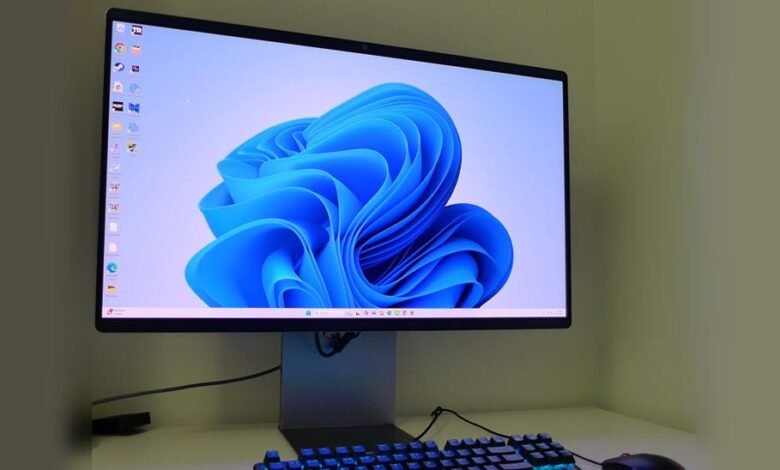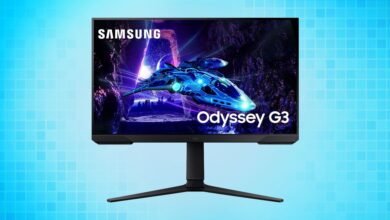Samsung M9 OLED Monitor Review: The Ultimate Gaming & TV Display

▼ Summary
– The Samsung M9 M90SF Smart Monitor combines features of a TV and computer monitor with a 4K OLED panel, 165Hz refresh rate for gaming, and TV streaming capabilities via Wi-Fi and a remote.
– It offers high-quality display features including HDR10 and HDR10+ support, 97% DCI-P3 color gamut coverage, and a peak brightness of over 450 nits for HDR content.
– Convenience features include a built-in 4K webcam, multiple USB ports, internal speakers, and panel protection systems like heatpipe cooling and logo detection to minimize pixel wear.
– The monitor is well-suited for gaming, productivity, and entertainment, with a premium design, anti-glare screen, and a three-year warranty, though its menu system can be confusing.
– Priced at $1,599, it is positioned as a versatile, all-in-one display ideal for small spaces or users seeking a single device for multiple uses, offering good value despite the high cost.
The Samsung M9 M90SF Smart Monitor presents a compelling fusion of high-performance gaming display and feature-rich entertainment center, delivering exceptional versatility for modern users. While its initial setup demands some adjustment, the payoff is a stunning visual experience that excels across gaming, media consumption, and productivity tasks.
Historically, televisions and computer monitors occupied distinct categories with separate functionalities. Televisions traditionally included broadcast tuners but lacked specialized computer connections, while monitors focused on computer graphics without television inputs. Digital technology has largely erased these boundaries, leaving DisplayPort capability and tuner inclusion as the primary differentiators today.
Samsung’s M9 M90SF effectively eliminates this remaining distinction by incorporating both DisplayPort with 165Hz refresh rate and Adaptive-Sync for gaming alongside HDMI inputs, Wi-Fi connectivity, and Samsung’s TV Plus streaming platform. The device leverages a spectacular 4K OLED panel with wide color gamut support, HDR10, and HDR10+ compatibility, creating a unified entertainment and work station in a single elegant chassis.
Key specifications include a 32-inch Quantum Dot OLED display with 3840×2160 resolution at 165Hz refresh rate. The monitor achieves a remarkably fast 0.03ms gray-to-gray response time and supports both FreeSync and G-Sync Compatible technologies. Color performance reaches 10-bit depth with extensive DCI-P3 coverage, while HDR content benefits from 450 nits peak brightness. Integrated audio comes from dual 5-watt speakers, and connectivity options encompass DisplayPort 1.4, HDMI 2.1, USB-C with 90-watt charging capability, and multiple USB-A ports.
Determining whether the M9 functions better as a television or monitor reveals its true hybrid nature. Gaming enthusiasts appreciate the high refresh rate, Adaptive-Sync support, and DisplayPort connection, while media consumers benefit from the comprehensive streaming interface, dedicated remote with quick-access buttons for popular services, and integrated microphone for voice assistants. The inclusion of Bluetooth and Apple AirPlay 2 further enhances its media capabilities, with the only notable omission being an antenna input for traditional broadcast television.
Visual performance stands out with the OLED panel delivering 138 pixels per inch density and approximately 97% DCI-P3 color coverage. While this falls slightly short of some competing QD-OLED displays, the monitor produces vibrant images with over 450 nits peak brightness for HDR content. The implementation of HDR10+ provides dynamic metadata similar to Dolby Vision, while dynamic tone mapping enhances standard HDR10 material.
Convenience features include an integrated 4K webcam within the screen bezel and multiple USB connectivity options. Samsung addresses potential OLED longevity concerns through an advanced heatpipe cooling system, along with logo and taskbar detection that automatically dims static screen elements to prevent burn-in. Periodic pixel refresh routines and a comprehensive three-year warranty provide additional peace of mind for this premium $1,599 investment.
Assembly proves straightforward with the monitor arriving in three components: base, upright, and panel. A Phillips-head screwdriver secures two captive bolts between the substantial metal base and stand, creating a stable foundation. The panel snaps securely into place, and Samsung includes a 100mm VESA mount compatibility for alternative mounting solutions, though users must supply their own fasteners.
Design aesthetics embrace minimalism with smooth silver plastic finishes accented by a metal base plate and all-metal rear panel that aids heat dissipation. The substantial upright provides robust ergonomic support including 25 degrees of tilt adjustment, 4.6 inches of height variation, and 90-degree portrait rotation capability. A matte front surface effectively minimizes ambient light reflections without compromising image sharpness or color fidelity, distinguishing it from the glossy finishes common to many OLED displays.
The included remote control simplifies navigation with a central directional pad and dedicated buttons for Netflix, Amazon Prime, YouTube, and Samsung TV Plus. A microphone enables Amazon Alexa and Google Assistant integration, though the absence of a direct input selection button requires menu navigation for source changes.
Rear-facing inputs remain easily accessible with cables routing neatly through the stand opening. The comprehensive connectivity suite includes HDMI 2.1, DisplayPort 1.4, USB-C with 90-watt power delivery, and two USB-A downstream ports. Power comes through a right-angle connector to an external power brick with sufficient cable length to place the unit on the floor.
Menu navigation presents some complexity as Samsung attempts to bridge television and monitor functionality. While improved over previous iterations, the interface shows different options depending on whether you’re gaming, computing, or watching television. The physical joystick positioned on the rear right side proves less convenient than the remote for most operations.
Picture settings offer extensive customization through the Expert Settings menu, including gamma adjustment, multi-point white balance calibration, color management, and various picture enhancements. The Movie picture mode delivers the most accurate color reproduction, adhering to BT.709 standards for SDR content and DCI-P3 for HDR material.
Gaming performance impresses with smooth motion handling at 165Hz, minimal input lag, and flawless Adaptive-Sync implementation. While some motion blur appears compared to 240Hz competitors, the difference becomes negligible during actual gameplay. HDR content appears vibrant and detailed, with Static tone mapping and Medium Peak Brightness providing optimal results across various content types.
Productivity usage benefits from the sharp 4K resolution, excellent contrast ratio, and effective anti-glare coating that reduces reflection concerns compared to glossy OLED alternatives. The panel’s pixel density creates crisp text and detailed images without visible pixel structure.
Streaming performance excels with seamless access to popular services through the intuitive home interface. HDR content from platforms like Netflix displays exceptional quality, while the integrated speakers outperform typical monitor audio with wider frequency response and soundstage. Dialogue remains clear and well-balanced without constant volume adjustments.
The menu system represents the primary area for improvement, with context-sensitive options creating occasional confusion. A dedicated input selection button on the remote would significantly enhance usability compared to navigating through on-screen menus.
Ultimately, the Samsung M9 M90SF succeeds as a triple-threat display solution. It performs admirably as a gaming monitor with smooth responsiveness, excels as a 4K HDR television with comprehensive streaming integration, and serves as an outstanding productivity display with superb image quality. While dedicated gaming monitors offer higher refresh rates, the M9 provides more than enough performance for most gamers while adding television functionality that traditional monitors lack. For users seeking a single display that genuinely does everything well, this premium investment delivers substantial value by combining three distinct display categories into one elegant solution.
(Source: Tom’s Hardware)





